人教版(2019)必修第二册Unit 1 Cultural Heritage Reading and Thinking From Problems to Solutions 课件(共18张PPT,内嵌
文档属性
| 名称 | 人教版(2019)必修第二册Unit 1 Cultural Heritage Reading and Thinking From Problems to Solutions 课件(共18张PPT,内嵌 |  | |
| 格式 | pptx | ||
| 文件大小 | 14.8MB | ||
| 资源类型 | 教案 | ||
| 版本资源 | 人教版(2019) | ||
| 科目 | 英语 | ||
| 更新时间 | 2024-05-16 10:30:24 | ||
图片预览

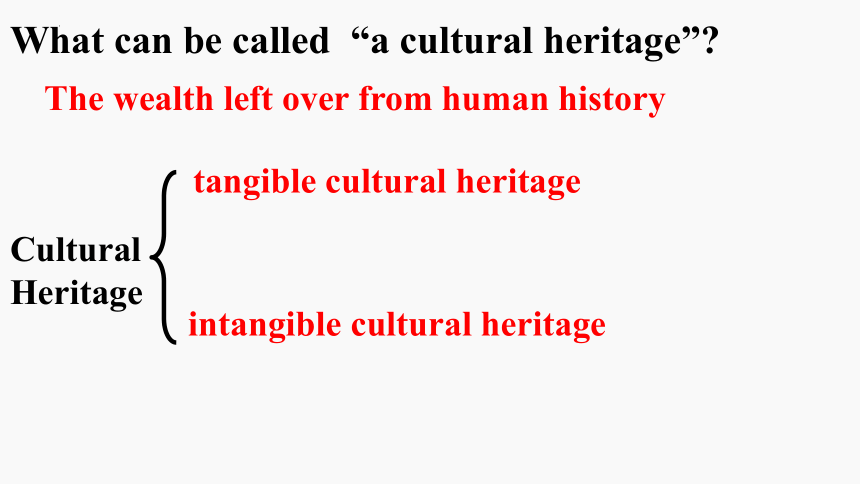

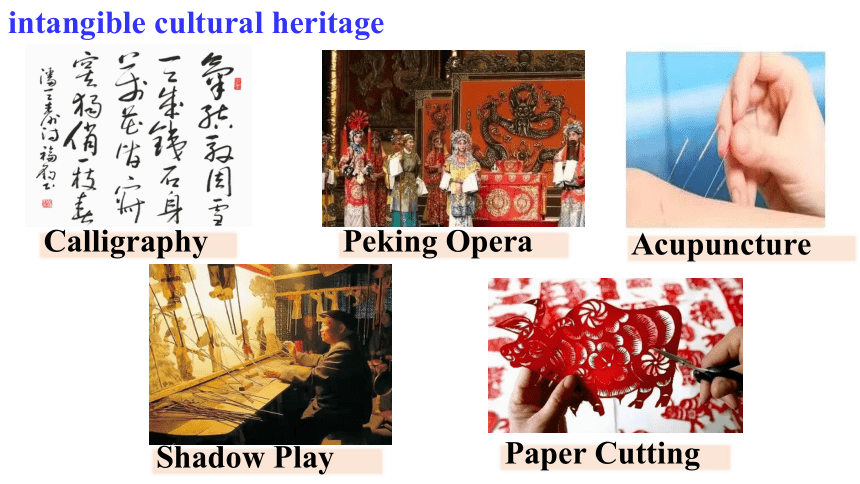
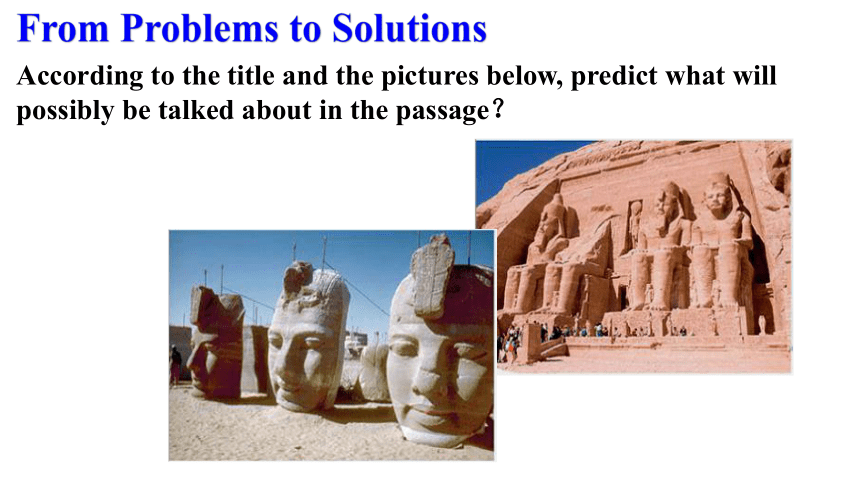
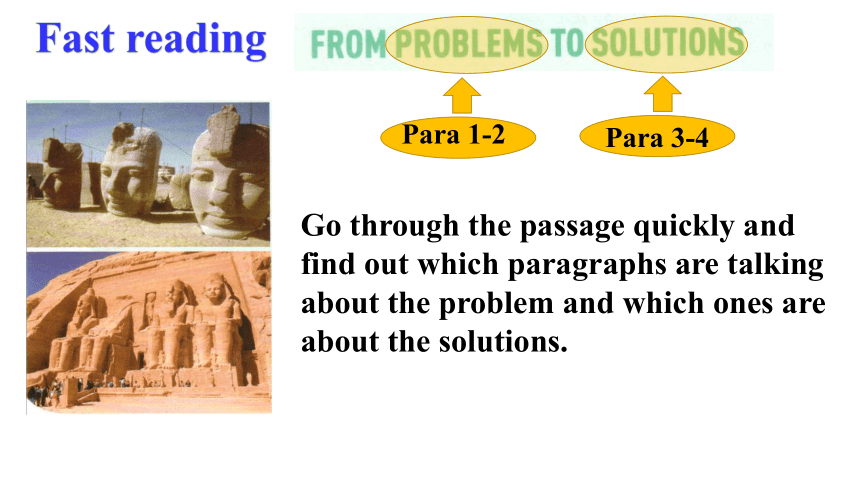
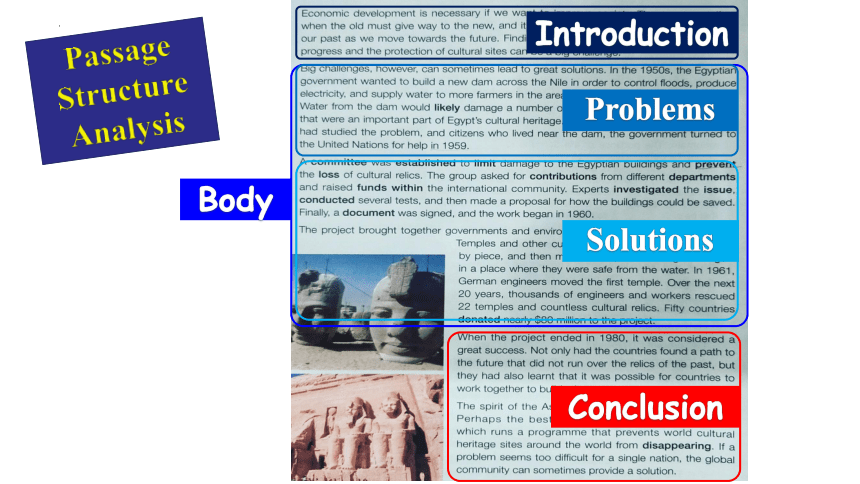
文档简介
(共18张PPT)
B2U1 Cultural Heritage
From Problems to Solutions
What can be called “a cultural heritage”
Cultural Heritage
tangible cultural heritage
intangible cultural heritage
The wealth left over from human history
tangible cultural heritage
the Great Pyramids
the Hanging Gardens of Babylon
Statue of Zeus
Terracotta Warriors
the Great Wall
intangible cultural heritage
Calligraphy
Peking Opera
Acupuncture
Shadow Play
Paper Cutting
From Problems to Solutions
According to the title and the pictures below, predict what will possibly be talked about in the passage?
Go through the passage quickly and find out which paragraphs are talking about the problem and which ones are about the solutions.
Para 1-2
Para 3-4
Fast reading
Passage Structure Analysis
Introduction
Problems
Solutions
Conclusion
Body
Para1-Para2
Para1
Economic development is necessary if we want to improve society. There comes a time when the old must give way to the new, and it is not possible to preserve everything from our past as we move towards the future. Finding and keeping the right balance between progress and the protection of cultural sites can be a big challenge.
1.What’s the challenge
2. What does the proposal refer to
3. What does protests mean
A. agreements
B. objections
C. actions
D. choices
4. Who did the government turn to
Careful reading
Para2
Big challenges, however, can sometimes lead to great solutions. In the 1950s, the Egyptian government wanted to build a new dam across the Nile in order to control floods, produce electricity, and supply water to more farmers in the area. But the proposal led to protests. Water from the dam would likely damage a number of temples and destroy cultural relics that were an important part of Egypt’s cultural heritage. After listening to the scientists who had studied the problem, and citizens who lived near the dam, the government turned to the United Nations for help in 1959.
2. What does the proposal refer to
To build a new dam across the Nile
3. What does protests mean
agreements
B. objections
C. actions
D. Choices
4. Who did the government turn to
the United Nations
Para1-Para2
Complete the timeline with the information from the text
The project starts. The temples and cultural relics are being rescued.
The projects is completed. The first temple is moved.
The government asks the UN for help.
The project starts.
1959
The government asks the UN for help.
1960
1961
The first temple is moved.
over next
20 years
The temples and cultural relics are being rescued.
1980
The projects is completed
What help did the UN offer
Para3-Para4
A committee was established to limit damage to the Egyptian buildings and prevent the loss of cultural relics. The group asked for contributions from different departments and raised funds within the international community. Experts investigated the issue, conducted several tests, and then made a proposal for how the buildings could be saved. Finally, a document was signed, and the work began in 1960.
1959
The government asks the UN for help.
1960
1961
over next
20 years
1980
What help did the UN offer
Para3
Thinking:
1.Who established a committee
2.What does the group refer to
3.Which institute (机构) do the experts work for
4.So what help did the UN offer
The UN.
It refers to the committee.
For the committee.
The project starts.
1959
The government asks the UN for help.
1960
1961
The first temple is moved.
over next
20 years
The temples and cultural relics are being rescued.
1980
The projects is completed
1.How were the temples and other cultural sites saved
They were taken down piece by piece and moved to other places where they would be safe from the water.
2.How long did it take to complete the project
20 years.
The project cost a lot of money. Many countries participated in the rescue and it is their team work that has saved the temples.
3. What can you infer from “ fifty countries donated nearly $80 million to the project”?
Para4
The project brought together governments and environmentalists from around the world. Temples and other cultural sites were taken down piece by piece, and then moved and put back together again in a place where they were safe from the water. In 1961, German engineers moved the first temple. Over the next 20 years, thousands of engineers and workers rescued 22 temples and countless cultural relics. Fifty countries donated nearly $80 million to the project.
Reading Para 3-4
Thinking
Why does the author use exact numbers
To give more detailed accounts of the project and make the writing more vivid and convincing.
What word can you think of to describe the working process of the project
Hard, complicated, amazing……
Para4
Reading Para 5-6
Find out the topic sentence in each paragraph
When the project ended in 1980, it was considered a great success. Not only had the countries found a path to the future that did not run over the relics of the past, but they had also learnt that it was possible for countries to work together to build a better tomorrow.
The spirit of the Aswan Dam project is still alive today. Perhaps the best example is shown by UNESCO, which runs a programme that prevents world cultural heritage sites around the world from disappearing. If a problem seems too difficult for a single nation, the global community can sometimes provide a solution.
Para5-Para6
What kind of spirit did Aswan Dam project show to us
It showed a kind of hard-working, determined spirit and a spirit of community.
Homework
Homework
before 1860
after the earthquake
before the earthquake
after1860
A lot of money was spent to protect or restore the cultural heritages.
Do you think it was worthwhile
Give your reasons.
Possible answer:
The significance of the existence of cultural heritage is to stimulate(激发) people’s feelings including love, pity, pain or hatred. It can help us remember and learn from the past and then develop forward.
Heritage is our legacy from the past, what we live with today, and what we pass on to future generations.
---World Heritage Centre
B2U1 Cultural Heritage
From Problems to Solutions
What can be called “a cultural heritage”
Cultural Heritage
tangible cultural heritage
intangible cultural heritage
The wealth left over from human history
tangible cultural heritage
the Great Pyramids
the Hanging Gardens of Babylon
Statue of Zeus
Terracotta Warriors
the Great Wall
intangible cultural heritage
Calligraphy
Peking Opera
Acupuncture
Shadow Play
Paper Cutting
From Problems to Solutions
According to the title and the pictures below, predict what will possibly be talked about in the passage?
Go through the passage quickly and find out which paragraphs are talking about the problem and which ones are about the solutions.
Para 1-2
Para 3-4
Fast reading
Passage Structure Analysis
Introduction
Problems
Solutions
Conclusion
Body
Para1-Para2
Para1
Economic development is necessary if we want to improve society. There comes a time when the old must give way to the new, and it is not possible to preserve everything from our past as we move towards the future. Finding and keeping the right balance between progress and the protection of cultural sites can be a big challenge.
1.What’s the challenge
2. What does the proposal refer to
3. What does protests mean
A. agreements
B. objections
C. actions
D. choices
4. Who did the government turn to
Careful reading
Para2
Big challenges, however, can sometimes lead to great solutions. In the 1950s, the Egyptian government wanted to build a new dam across the Nile in order to control floods, produce electricity, and supply water to more farmers in the area. But the proposal led to protests. Water from the dam would likely damage a number of temples and destroy cultural relics that were an important part of Egypt’s cultural heritage. After listening to the scientists who had studied the problem, and citizens who lived near the dam, the government turned to the United Nations for help in 1959.
2. What does the proposal refer to
To build a new dam across the Nile
3. What does protests mean
agreements
B. objections
C. actions
D. Choices
4. Who did the government turn to
the United Nations
Para1-Para2
Complete the timeline with the information from the text
The project starts. The temples and cultural relics are being rescued.
The projects is completed. The first temple is moved.
The government asks the UN for help.
The project starts.
1959
The government asks the UN for help.
1960
1961
The first temple is moved.
over next
20 years
The temples and cultural relics are being rescued.
1980
The projects is completed
What help did the UN offer
Para3-Para4
A committee was established to limit damage to the Egyptian buildings and prevent the loss of cultural relics. The group asked for contributions from different departments and raised funds within the international community. Experts investigated the issue, conducted several tests, and then made a proposal for how the buildings could be saved. Finally, a document was signed, and the work began in 1960.
1959
The government asks the UN for help.
1960
1961
over next
20 years
1980
What help did the UN offer
Para3
Thinking:
1.Who established a committee
2.What does the group refer to
3.Which institute (机构) do the experts work for
4.So what help did the UN offer
The UN.
It refers to the committee.
For the committee.
The project starts.
1959
The government asks the UN for help.
1960
1961
The first temple is moved.
over next
20 years
The temples and cultural relics are being rescued.
1980
The projects is completed
1.How were the temples and other cultural sites saved
They were taken down piece by piece and moved to other places where they would be safe from the water.
2.How long did it take to complete the project
20 years.
The project cost a lot of money. Many countries participated in the rescue and it is their team work that has saved the temples.
3. What can you infer from “ fifty countries donated nearly $80 million to the project”?
Para4
The project brought together governments and environmentalists from around the world. Temples and other cultural sites were taken down piece by piece, and then moved and put back together again in a place where they were safe from the water. In 1961, German engineers moved the first temple. Over the next 20 years, thousands of engineers and workers rescued 22 temples and countless cultural relics. Fifty countries donated nearly $80 million to the project.
Reading Para 3-4
Thinking
Why does the author use exact numbers
To give more detailed accounts of the project and make the writing more vivid and convincing.
What word can you think of to describe the working process of the project
Hard, complicated, amazing……
Para4
Reading Para 5-6
Find out the topic sentence in each paragraph
When the project ended in 1980, it was considered a great success. Not only had the countries found a path to the future that did not run over the relics of the past, but they had also learnt that it was possible for countries to work together to build a better tomorrow.
The spirit of the Aswan Dam project is still alive today. Perhaps the best example is shown by UNESCO, which runs a programme that prevents world cultural heritage sites around the world from disappearing. If a problem seems too difficult for a single nation, the global community can sometimes provide a solution.
Para5-Para6
What kind of spirit did Aswan Dam project show to us
It showed a kind of hard-working, determined spirit and a spirit of community.
Homework
Homework
before 1860
after the earthquake
before the earthquake
after1860
A lot of money was spent to protect or restore the cultural heritages.
Do you think it was worthwhile
Give your reasons.
Possible answer:
The significance of the existence of cultural heritage is to stimulate(激发) people’s feelings including love, pity, pain or hatred. It can help us remember and learn from the past and then develop forward.
Heritage is our legacy from the past, what we live with today, and what we pass on to future generations.
---World Heritage Centre
